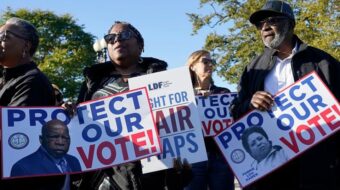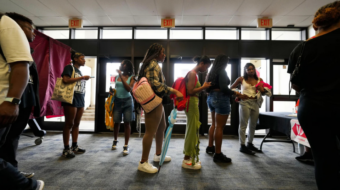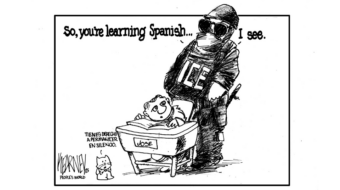Editor’s note: A U.S. postage stamp is being released Tuesday, April 22, 2008, honoring Latino journalist Ruben Salazar, who was killed during an anti-Vietnam War protest in 1970.
Salazar was a Los Angeles Times reporter who covered the Vietnam War and then became news director for the Spanish-language television station KMEX in January 1970.
Salazar was 42 when he was struck by a tear gas projectile fired by a sheriff’s deputy in August 1970 while covering the Chicano Moratorium in East Los Angeles.
The City Council has declared Tuesday ‘Ruben Salazar Day’ in Los Angeles. Council President Eric Garcetti says the Salazar stamp will allow his story to ‘be retold to a new generation.’
The Salazar stamp is part of a five-stamp pane honoring journalists who risked their lives reporting some of the most important events of the 20th century.
The following article about Salazar was originally published in People’s World newspaper Saturday, Sept. 12, 1970, Vol. 33 No. 37. People’s World was the PWW’s West Coast forerunner.
LOS ANGELES – Ruben Salazar has been eulogized as “a most uncommon man.” The description is apt.
He was perceptive and talented. Above all, he was a dedicated man of principle.
To many of Ruben’s closest co-workers the source of his strength and effectiveness was precisely that he was very much a common man, one with his people, sharing their frustrations and anger and seeking desperately for the ways and means of highlighting their problems.
In recent months he had found what he believed strongly was a better way to express himself than ever before. As news director of KMEX the Spanish language TV station here, and as a weekly columnist for the Los Angeles Times he reached out to two worlds with which he felt he must communicate.
Nightly, news about the Chicano community was aired in the language of his people as never before. No punches were held.
When two Mexican nationals were brutally killed by police in mid-July, the surviving Mexicans who were present in the room where the shooting took place, told the story of that killing to the Spanish-speaking community in Los Angeles in great detail on KMEX.
It was an effective and dramatic presentation, so effective, Ruben later told me, that the police visited the station the next morning to question the advisability of his airing the program.
Two audiences
But Ruben strongly believed that he also must communicate in another direction – with the Anglo community which knows almost nothing about the Chicanos and seemed to care little, if at all, about their problems.
That is why his hard-hitting weekly column on Chicano grievances in the Times was so important to him. It was sharp, and often abrasive. But here was the first Chicano columnist in the paper, laying it on the line.
He scoffed at suggestions by his editors that he ease up on the social problems and concentrate on the “folk ways” of the Chicanos.
“That’s all we need, another writer telling about tacos, enchiladas and burritos,” he said.
Salazar had come to a hard decision when he left the Times staff some months ago after 11 years on that paper. He dropped the “objectivity” pose like it was a heavy cape weighing him down.
He worked harder than at any time in the years I have known him. Now he was an advocate, a proud and articulate spokesman for the Chicano point of view. It was a labor of love, not just a job.
All during the day on which he was shot in the back of the head by a sheriff’s deputy, Aug. 29, he proudly wore the button on his gold colored shirt. It was still on him when he was killed.
Earlier in the day we had talked about his wearing that button. He told me he now felt free of the tight strictures of so-called objectivity which is imposed by the commercial mass media.
“It feels better this way,” he said.
Ruben and I worked together on stories in Denver covering the historic 1969 Chicano youth conference, in Fresno, where many Chicano political conventions were held, in Imperial Valley, marching with farm workers and most often of all in the Los Angeles barrio.
We never competed for stories, we worked together. During the great Mexicali demonstration against the salinization of the Baja California farm lands Salazar was on the scene.
He wrote graphic accounts of the demonstrations. Finally aroused by his comments, I called him at the Hotel de Anza in Calexico and asked if there was a special story there for the People’s World.
‘Gringo paper’
“Sure come on down, they are your kind of people,” Salazar said in commenting on the leaders of the demonstration. “They refuse to talk to me because I work for a gringo newspaper. They are Marxists.”
He was right. I rushed down there and the strike leaders after checking my credentials, granted me an interview which became a major front-page story in the People’s World the following week.
I remember well the conversation we had following his decision to become a foreign correspondent for the Times. He was fed up with the frustrations of being a Chicano reporter on an Anglo newspaper which understood so little the problems of his people. He talked bluntly of some of the editors, whom he described as “racist.”
“To get ahead in this (newspaper) business I’ve got to get out of the bind,” he said, “Chicano news isn’t big news you can’t make a name for yourself in this business.”
Just before he left for Saigon he asked me, half jokingly I presumed, whether I could supply him with contacts he might be able to make with the National Liberation Front in Vietnam. He was quite serious, he assured me.
When Salazar returned from his tour as a foreign correspondent in Vietnam, the Dominican Republic and Mexico, we spent hours together talking about the developments in the Chicano movement in the U.S. Now he was a recognized “name” writer whose by-line was well known to Times readers and to others who subscribed to the Times service syndicate.
When he became a columnist for the Times and KMEX’s news director Ruben opened up a new chapter in his life and a new avenue of relationships with the Chicano community that endeared him to many thousands.
It was an all too brief chapter.
New chapter
The National Chicano Moratorium was something special to Salazar. He had looked forward to once again working on an assignment and free, for the moment, from the interminable editing and deskwork that occupied so much of his time as news editor.
He was conscious of the question asked many times by people in the community, “is Salazar coming to cover this?” Man knew him personally and to many Chicanos his presence signified that it was a major event.
He was elated by the Moratorium turnout. For him it was a day of exchanging greetings with his hundreds of friends.
When the four-mile march through the barrio got under way the KMEX car preceded it. Salazar, mindful of the surgery I underwent several months ago, waved me into the car and insisted that I not strain myself by walking the entire distance.
Most of that day we were together. He was at my left at the Laguna Park platform when the mass meeting got under way. Then came the disturbance at the rear, which we, as well as the persons on the platform felt was only a minor disturbance
Final glimpse
Little did we know then that the sheriff’s deputies were massing for a brutal assault on the peaceful assemblage? All too soon we realized the gravity of the situation. And when the tear gas canisters landed on the fields, with smoke billowing up to the platform, we made our separate ways to momentary safety.
My eyes tearing from the gas saw Ruben alive for the last time at that moment. Within a couple of short hours he lay dead on the floor of the tear gas filled Silver Dollar Café.
Thus came to an end the life and career of one of the most articulate voices of the Chicano people. His loss is an immense one to his people. It is a great loss to all who have decency within them.
Adios, Ruben, mi amigo, Chicanos – and all oppressed people in whose behalf you spoke so eloquently – will remember and avenge you.










